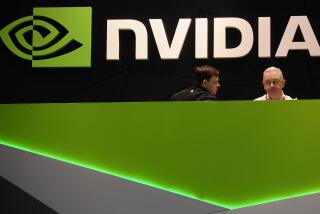Sega Scoring Points
Sonic the Hedgehog is back.
After pulling the plug on its money-draining Dreamcast console last year, video game company Sega Corp. has rebounded with an operating profit and a lineup of must-have titles that are turning former rivals Sony Corp., Nintendo Co. and Microsoft Corp. into suitors.
Though it’s too early to declare Sega a financial success, analysts said Sega has transformed itself from a struggling hardware-focused company to one of the industry’s most important software companies.
“They’re one of the best comeback stories of the year,” said P.J. McNealy, senior analyst for technology consulting firm Gartner Inc. “They were able to pare off under-performing units and really reposition themselves as a significant software player in less than 18 months.”
Nowhere was Sega’s transformation more evident than at last month’s Electronic Entertainment Expo, or E3, the industry’s biggest trade show. At an after-hours event at Sega’s relatively modest booth, key executives from Nintendo, Microsoft and Sony buried hatchets and paid homage. Gamers lined up to get autographs from Sega developers, who passed out baseball cards instead of business cards as Sega games ran on Sony’s PlayStation 2, Microsoft’s Xbox and Nintendo’s GameCube.
No one mentioned the Dreamcast, least of all Sega executives, who were painfully aware that the company poured more than $1 billion into the console before discontinuing it in March 2001. The experience left Sega with $1.5 billion in debt, nearly the same amount as its annual revenue.
The decision to quit the hardware business after 15 years left fans and investors with a bad taste. Many predicted that the company would become irrelevant. Takeover rumors swirled, with reports that Nintendo or Microsoft would purchase Sega. With Sega’s future clouded, speculation was rampant that the company’s developers would bolt. But Sega managed to hang on to most of its independence and most of its key talent.
The developers did not disappoint. In the first three months of this year, Sega was the No. 1 independent publisher for GameCube, selling 22% of the games for that console. It also was the No. 3 publisher for PlayStation 2 in the same period with 7% of all games sold, boosted by strong sales of “Virtua Fighter 4” and “NBA2K2.” Last year, Sega’s “Jet Set Radio Future” and “Super Monkey Ball” bolstered the lineup of games at the launch of Xbox and GameCube.
At E3 this year, Sega’s games continued to garner buzz.
“They have a fantastic lineup,” said Geoff Keighley, a writer for Gamespot, an online game site. “Sega is without a doubt one of the most important third-party publishers for these consoles. You have ‘Shinobi’ on PS2. On Xbox, there’s ‘Panzer Dragoon,’ based on their classic franchise. And ‘Sonic’ is on GameCube. For gamers, these franchises are huge.”
Sega’s ability to recover lies in these franchises, which the company has aggressively milked for revenue this last year. An example of this strategy is “Sonic Adventure 2 Battle” for GameCube. The game--essentially identical to “Sonic Adventure 2” for the Dreamcast--sold 280,000 copies for the GameCube. Much of the revenue was gravy since the title required only minor changes in the Dreamcast version.
“That’s revenue we would not have otherwise seen,” said Peter Moore, president of Sega of America, the parent company’s U.S. arm. “We’ve been unleashed from the Dreamcast.”
Console makers, eager to get their hands on Sega’s games, will be in the position of helping their former foe by giving Sega extra marketing and development dollars if it agrees to put games exclusively on their consoles.
“Clearly, bringing a character like Sonic to the GameCube was very important to Nintendo,” said George Harrison, senior vice president of marketing for Nintendo.
Financially, Sega is not out of the woods. Though the company saw a $111.5-million operating profit for its fiscal year ended March 31, a $258.3-million loss from stock market investments resulted in an overall $140-million net loss.
“When there have been profits or losses in the past at Sega, they have been large,” said Mark Cerny, president of Cerny Games in Los Angeles and a former Sega developer. “It’s easy to make or lose $50 million in this business. The trick is going to be consistency and making the profits year in and year out.”
Never short on confidence, Sega declared at E3 that the company aims to become North America’s second-largest game publisher after Electronic Arts Inc. by the end of the year. For its last fiscal year, Sega’s North American revenue was $201 million, compared with EA’s $952 million, Activision Inc.’s $308 million, and THQ Inc.’s $280 million.
Even if Sega achieved its goal, the company still would be a distant second to EA, which is expected to top $1.2 billion in sales in North America this year, according to estimates from UBS Warburg. To catch up, Sega is shopping for studios and publishers.
“Sega will pursue an aggressive acquisition strategy to further reinforce its video game console publishing business,” said Charles Bellfield, Sega’s vice president of strategic planning.
Last year, Sega saw 26.6% of its revenue from North America, 10% in Europe and 61.6% from Japan, much of it from its arcade business. But with Japan’s economic doldrums and a weak arcade market, Sega is looking to the U.S. for growth and profit.
Sega’s success or failure ultimately rests on continuing to crank out killer games.
“If they keep bringing the same quality of software they have in the past,” Harrison said, “they will easily be one of the top five publishers in our industry for some time to come.”






